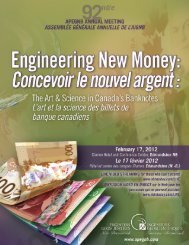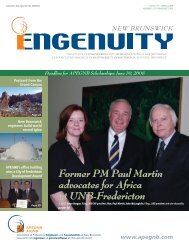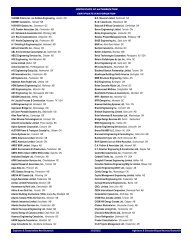Download - Engineers & Geoscientists New Brunswick
Download - Engineers & Geoscientists New Brunswick
Download - Engineers & Geoscientists New Brunswick
You also want an ePaper? Increase the reach of your titles
YUMPU automatically turns print PDFs into web optimized ePapers that Google loves.
PRESIDENT’S REPORT<br />
20<br />
BRUCE E. BROSTER,<br />
Ph.D., P.Geo., FEC (Hon.)<br />
My year serving as your<br />
President is rapidly<br />
approaching its end<br />
and at this time, it is<br />
customary to look back over our<br />
accomplishments and highlights<br />
for the year.<br />
The position of APEGNB<br />
President is one that requires the<br />
incumbent to dive in and keep<br />
swimming. By the time you<br />
come up for air, it is time for<br />
someone new to take over.<br />
Items surfaced after one day on<br />
the job and within two weeks,<br />
Andrew McLeod, FEC (Hon.), and<br />
I were off to Ottawa to attend<br />
<strong>Engineers</strong> Canada’s (CCPE) plenary<br />
sessions and discussions of the<br />
Synergy Task Force proposals.<br />
During the year, I attended more<br />
than 50 meetings as part of my<br />
duties as APEGNB President. I was<br />
also active during a transition as<br />
outgoing <strong>Geoscientists</strong> Canada<br />
(CCPG) Past President to<br />
incoming chair of the Canadian<br />
Geoscience Standards Board.<br />
During the past 10 months, I<br />
have represented your Association<br />
at the annual general meeting of<br />
approximately six of our sister<br />
associations across Canada—<br />
from the Northwest Territories<br />
and Nunavut to <strong>New</strong>foundland<br />
and Labrador. From these travels,<br />
it was clear that the associations<br />
face similar challenges and<br />
THE PROFESSIONAL ENGINEER AND GEOSCIENTIST – February 2011<br />
INGÉNIEUR ET GÉOSCIENTIFIQUE – février 2011<br />
goals, which are best served by a<br />
united front through our national<br />
associations of <strong>Engineers</strong> Canada<br />
and <strong>Geoscientists</strong> Canada.<br />
The major challenges facing all<br />
associations continue to be:<br />
1. illegal practice by<br />
non-licensed professionals;<br />
2. fair and rapid assessment of<br />
Foreign Trained Professionals<br />
(FTP); and,<br />
3. ease of mobility.<br />
While the Agreement on Internal<br />
Trade (AIT) has facilitated national<br />
mobility for full members, we<br />
face issues on partial or limited<br />
licensure and this will be at the<br />
forefront over the next year.<br />
Our national associations continue<br />
to work towards greater international<br />
mobility on behalf of<br />
all Canadian engineers and<br />
geoscientists. <strong>Engineers</strong> Canada<br />
has negotiated a recognition<br />
agreement on full professional<br />
practice, the NAFTA Mutual<br />
Recognition Document, to<br />
support greater mobility for<br />
engineers from Canada, Texas<br />
and Mexico. <strong>Engineers</strong> Canada<br />
has also developed a national<br />
register of qualified Canadian<br />
engineers as part of the Asia<br />
Pacific Economic Cooperation<br />
(APEC) Engineer Register initiative.<br />
Geoscience Canada is examining<br />
agreements with Ireland, the<br />
United Kingdom, Italy and<br />
Spain. In November, I attended<br />
the National Association of<br />
State Boards of Geology<br />
(ASBOG) Annual Meeting of<br />
30 state boards in St. Louis,<br />
Missouri, and contributed to<br />
their Committee of Examiner<br />
meetings for Fundamental<br />
Monument to the builders of the Gateway Arch at<br />
St. Louis, MO, located in the Visitors Centre under<br />
the arch. The 630-foot high stainless steel arch was<br />
built between 1963-65 to symbolize the city’s<br />
role as ‘Gateway to the West’.<br />
Exams (FG) and Practice Exams<br />
(PG). In the United States,<br />
professional practice is licensed<br />
by individual states—many of<br />
whom require that applicants<br />
pass the ASBOG FG and PG<br />
examinations for approval of<br />
licensure. Some Canadian<br />
associations, especially APEGGA,<br />
are looking at adopting the<br />
ASBOG FG as a requirement for<br />
FTP geoscience applications.<br />
The Gateway Arch, St. Louis, Missouri—symbol of the<br />
city’s position as the gateway to expansion westward<br />
of the Mississippi River.





